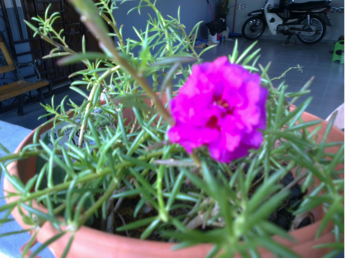Ros Jepun
| Rosa Jepun | |
| Scientific Name | Portulaca grandiflora Hook |
| Synonyms | Portulaca pilosa ssp. Grandiflora |
| Family | Portulacaceae |
 |
{slider=Common Name}
Rose Moss
{/slider}
{slider=Chemical Composition}
Total ash and acid insoluble ash contents were not more than 20 % & 7 %. Moisture content not more than 9 % (Niumsakul S. et al 2008). P. grandiflora produces the alkaloid type betalain pigment in its petals and stems (Rossi-Hassani BD & Zryd JP 1994). Sterols, carotenoids-in the etheric extract; phenolic acids-in the ethanolic extract; polysaccharides, reducing agents in the aqueous one. Sterol, caffeic acid and chlorogenic acids, quercetol and heterosides and kaempferol ( Anghel AI et al 2013).
{/slider}
{slider=Geographical Distribution}
Native to southern Brazil, Uruguay and norther Argentina
{/slider}
{slider=General Appearences}
Erect herb with subterranean stem. The pseudo stem is made up of leaves sheaths (Globinmed)
{/slider}
{slider=Traditional Uses}
To relief sore throat, skin rash and detofication
{/slider}
{slider=Pharmacology}
The highest antioxidant activity of plant extracts in acetone extract of orange variety. The leaf content the highest phenolic content and antioxidant activity (Lim CK et al 2014)
{/slider}
{slider=Toxicology Study}
Water extract pf P. grandiflora at doses 10, 100 and 1000 mg/kg per day did not induce any detrimental effects in the male and female Wistar rats in chronic toxicity study for 6 months.The aqueous extract did not demonstrate any relevant serious signs or significant changes in hematological, biochemical and histopathological parameters even at dose of 1000mg/kg/day (Chacalittumrong P 2004).
{/slider}
{slider=Reference}
Anghel A I., O.T. Olaru, F. Gatea, M. Dinu, Robert Viorel Ancuceanu, V. Istudor (2013). Prelimanary research on Portulaca grandiflora Hook. Species (Portulacaceae) for therapeutic use. Farmacia vol 61 (4), P 694-702
Chacalittumrong P., Chivapat S. Attawish A., Bansiddhi J. Phadungpat S. Chaorai B., Butrapom R. (2004). Chronic toxicity study of Portulaca grandiflora Hook. J. Ethnopharmacol 90, 2-3, Pg 375-380.
Lim C K , W. N. Thiong, J. L. Loo (2014). Antioxidant activity and total phenolic content of different varieties of Portulaca grandiflora. International Journal of Phytopharmacy Vol 4, 1,
Niumsakul S., A. Sakpetch, J. Bansiddhi, T. Boonruad, P. Wongsinkongman, P. Chacalittumrong (2008) Chemical Specification of Dried Aerial Parts of Portulaca grandiflora Hook.f. 6 (2).
Rossi-Hassani BD, Zryd JP (1994). Genetic instability in Portulaca grandiflora (Hook). Ann Genet. 37 (2): 53-9.
{/slider}
- Last updated on .
- Hits: 1963
